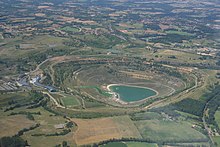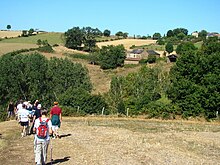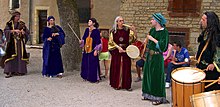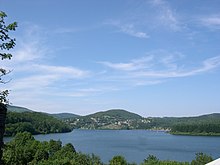This article contains content that is written like an advertisement .(August 2012) |
The Tarn department is located in the southwest of France.
This article contains content that is written like an advertisement .(August 2012) |
The Tarn department is located in the southwest of France.
In 2009, there were:



Steeped in history, from the Cathar era to the Industrial Revolution, the Tarn department has a rich heritage of fortified villages, castles, churches and museums. While the south-western houses are mostly stone-built, cities from the northwest of the department are often made of the local red brick, typical of the region.
The department is also known for its heritage of remarkably well-preserved bastides (fortified villages built in the 13th century to protect the population from the Wars of Religion). Famous bastides include:
Other renowned villages in the Tarn:


Many outdoor activities such as hiking, skiing, canoeing and canyoneering can also be ways to discover the department and its landscapes. Tourists can also go swimming, fishing or sailing in the various lakes, either in the natural parks or in the rivers.
Close to Carmaux, Cap'Découverte, one of the greatest European leisure and adventure parks, located in a former open-sky mine, offers a wide range of activities: skiing or snowboarding on a synthetic track, swimming, biking, and such facilities as a luge track, a giant zip-line, a skate park, mini go-karts, a Mining Museum...
The Tarn offers golf courses for every level, from beginners to professional players. (see the Lasbordes Golf course in Albi).
Further South, the Regional nature park of Haut-Languedoc and the Sidobre, a 245-million-year-old granite plateau, are nice places for a relaxing stay.
From the Tarn Valley to the Monts de Lacaune and the Montagne Noire, you can discover the “Pays de Cocagne” from various angles: along with the stream, up in the air, among the trees, or with the many routes and GR Trails.
In Albi or in Castres, mini-cruises in barges inspired by the traditional wooden boats are a good way to discover the secrets of the Tarn and Agoût Rivers.
The Chemin de Fer Touristique du Tarn (CFTT), or “Tarn Light Railway”, organises trips in the countryside in an authentic steam train.
Several parks and gardens are visible throughout the department.
The 3,500 km of hiking trails of the department can be explored trekking, biking or on horseback, with several regional horse farms organising riding tours.

The Tarn offers a great diversity of cultural events. The Albi Carnival sets the tone in February and marks the kick-off of many festivals:
Other events :
The Grand Prix d'Albi takes place each year in September in the Circuit d'Albi-Le Sequestre.

The major family-oriented festivals and events in Tarn include:

The Tarn is known for its terroir cuisine, local gastronomy and regional products that include: the delicatessen of Lacaune, the Pink Garlic of Lautrec, Gaillac wines…
The Gaillac wine, one of the great wines of Southwest of France, is a testimony of the rich and authentic culture of the Midi Toulousain. Gaillac winemakers still use today the specific grape varieties and methods this millenary vineyard if famous for.
The Pink Garlic of Lautrec comes in the form of a bulb with cloves (or bulblets) of a beautiful pink color. Its long period of dormancy gives it exceptional natural features of dry conservation.
Pork is a local specialty in Lacaune, where many sorts of delicatessen are produced: famous varieties of ham, sausages, and typical meats such as the melsat and the bougnettes...

Tarn offers a wide range of institutions that can suit any kind of tourism and vacation plans: farmhouse inns, guest houses, bed and breakfast housing as well as campsites, hotels or Village Vacances… As of 2010 there were:
"Tourism and Handicap" is a national label created by the Ministère du Tourisme. The result of a close collaboration between user groups and tourism professionals, it certifies that the main resorts and tourist attractions are accessible to people with disabilities, regardless of their disability. Each site is subject to an inspection conducted by trained assessors for this purpose.
In Tarn, about thirty providers are already accredited (accommodations, museums, etc.).

The Province of Languedoc is a former province of France. Most of its territory is now contained in the modern-day region of Occitanie in Southern France. Its capital city was Toulouse. It had an area of approximately 42,700 square kilometers.

Tarn is a department in the Occitania region in Southern France. Named after the river Tarn, it had a population of 389,844 as of 2019. Its prefecture and largest city is Albi; it has a single subprefecture, Castres. In French, the inhabitants of Tarn are known as Tarnais (masculine) and Tarnaises (feminine). Its INSEE and postcode number is 81.

Albi is a commune in southern France. It is the prefecture of the Tarn department, on the river Tarn, 85 km northeast of Toulouse. Its inhabitants are called Albigensians. It is the seat of the Archbishop of Albi.

The following is a list of the 314 communes of the Tarn department of France.

Castres is the sole subprefecture of the Tarn department in the Occitanie region in Southern France. It lies in the former province of Languedoc, although not in the former region of Languedoc-Roussillon. In 2018, the commune had a population of 41,795.

The Tarn is a 380.2-kilometre (236.2 mi) long river in the administrative region of Occitania in southern France. It is a right tributary of the Garonne.

Mazamet is a commune in the Tarn department in southern France.

Lavaur is a commune in the Tarn department in southern France.

Gaillac is a commune in the Tarn department in southern France. It had in 2013 a population of 14,334 inhabitants.

Cordes-sur-Ciel is a commune in the Tarn department, region of Occitania, Southern France. The fortified town was built in 1222 by Raimond VII, the Count of Toulouse, who, though not a Cathar, tolerated what other Catholics considered heresy.

The arrondissement of Albi is an arrondissement of France in the Tarn department in the Occitanie region. Its INSEE code is 811 and its capital city is Albi. It has 163 communes. Its population is 191,150 (2016), and its area is 2,731.7 km2 (1,054.7 sq mi). It is the northernmost of the arrondissements of the department.

The arrondissement of Castres is an arrondissement of France in the Tarn department in the Occitanie region. Its INSEE code is 812 and its capital city is Castres. It has 151 communes. Its population is 195,298 (2016), and its area is 3,026.2 km2 (1,168.4 sq mi). It is the southernmost arrondissement of the department.
The following is a list of the 23 cantons of the Tarn department, in France, following the French canton reorganisation which came into effect in March 2015:

Lisle-sur-Tarn is a commune in the Tarn department in southern France.

Lamontélarié is a commune in the Tarn department in southern France.

Castelnau-de-Montmiral is a commune in the Tarn department in southern France.

Burlats is a commune in the Tarn department and Occitanie region of southern France.

The Cérou is an 87.1 km (54.1 mi) long river in the Aveyron and Tarn departments in southern France. Its source is at Saint-Jean-Delnous, 1.8 km (1.1 mi) northwest of the village. It flows generally west-northwest. It is a left tributary of the Aveyron, into which it flows at Milhars, 1.4 km (0.87 mi) north of the village.

Lautrec Pink Garlic is a protected geographical indication indicating a specific production of garlic from the Lautrec commune in the Tarn department in southern France.